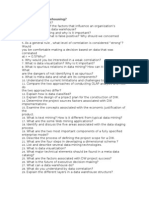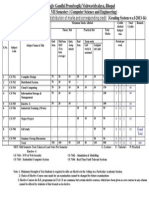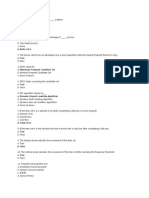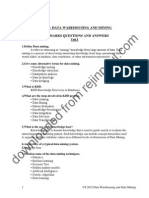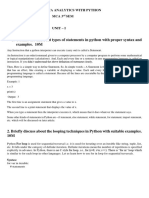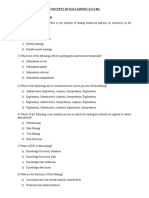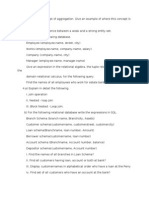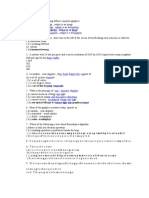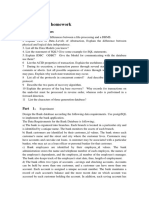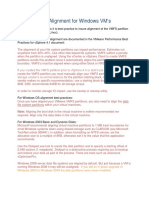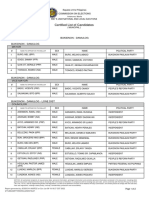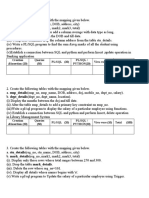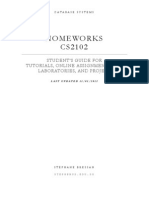DWDM Important Questions
DWDM Important Questions
Uploaded by
jyothibellary2754Copyright:
Available Formats
DWDM Important Questions
DWDM Important Questions
Uploaded by
jyothibellary2754Copyright
Available Formats
Share this document
Did you find this document useful?
Is this content inappropriate?
Copyright:
Available Formats
DWDM Important Questions
DWDM Important Questions
Uploaded by
jyothibellary2754Copyright:
Available Formats
1.a) Explain the storage models of OLAP?
b) How does the data warehousing and data mining work together. 2. Suppose that the data for analysis includes the attribute age. the age values for the data tuples are increasing order 13 16 16 23 23 25 25 25 25 30 30 30 30 35 35 35 40 40 45 45 45 70 a) How might you determine the outliers in the data? b) What other methods are there for data smoothing? 3. List and describe the primitives for the data mining task? 4. Why perform attribute relevance analysis? Explain the various methods of it's? 5.a) How is association rules mined from large databases? b) Describe the different classifications of associate rule mining? 6. How will you solve a classification problem using decision trees? 7.a) What are the fields in which clustering techniques are used? b) What are the major requirements of clustering analysis? 8. Write short notes on: i) Discriminating different classes ii) Statistical measures in large databases. 9. Briefly compare and explain by taking an example of your point(s). a) Snowflake schema, fact constellation b) Data cleaning, data transformation. 10.a) Discuss various issues in data integration? b) Explain the concept hierarchy generation for categorical data? 11.a) Why is it important to have a data mining query language? b) Define schema and operation-derived hierarchies? 12. Outline a data cube-based incremental algorithm for mining analytical class comparisons? 13. List and explain the five techniques to improve the efficiency apriori algorithm? 14. What is backpropagation? Explain classification by back-propagation? 15. Why is outlier mining important? Discuss about different outlier detection approaches? Briefly discuss about any two hierarchical clustering methods with suitable examples? 16. Write short notes on: i) Mining Spatial Databases ii) Mining the World Wide Web. 17.a) Differentiate between OLAP and OLTP? b) Draw and explain the star schema for the data warehouse? 18. What is data compression? How would you compress data using principle component analysis (PCA)? 19. List and describe the various types of concept hierarchies? 20. List the statistical measures for the characterization of data dispersion, and discuss how they can be computed efficiently in large data bases? 21. What is Divide and Conquer? How it could be helpful for FP Growth method in generating frequent item sets without candidate generation? 22. Can we get classification rules from decision trees? If so how? What are the enhancements to the basic decision tree? 23. What are the different types of data used in cluster analysis? Explain in brief each one with an example? 24. Write short notes on: i) Data objects ii) Sequence Data Mining iii) Mining Text Databases.
25. What are the various issues in data mining? Explain each one in detail? 26. Why preprocess the data and explain in brief? 27. Write short notes on GUI, DMQL? How to design GUI based on DMQL? 28. How is class comparison performed? Can class comparison mining be implemented efficiently using data cube techniques? If yes explain? 29. Describe example of data set for which apriori check would actually increase the cost? 30. Explain the various preprocessing steps to improve the accuracy, efficiency, and scalability of the classification or prediction process? 31.a) What are the differences between clustering and nearest neighbor prediction? b) Define nominal, ordinal, and ratio scaled variables? 32.a) What are the various issues relating to the diversity of database types? b) Explain how data mining used in health care analysis? 33.Constraint based mining? Briefly discuss the possible constraints in high level declarative DMQL & User Inteface 34. Describe multidimensional associative rule mining from relational databases? 35. What is Associative mining? Briefly describe the criteria for classifying associative rules? 36. What is Back Propagation? Describe Back Propagation? Describe Back propagation Algorithm? 37. Briefly outline the major steps of decision tree classification? 38. What is Misclassification rate of a classifier? Describe Sensitivity & specify measures of a classifier? 39. What is Density based Clustering? Describe DB Scan clustering algorithm? 40. Cluster Analysis? Describe the dissimilarity measures for internal Scale variables & binary variables? 41. Multimedia DataMining? How similarity search can be perfomed on Multimedia data? Describe contents of a multimedia data cube? 42. Spatial data? Time series data? Briefly describe the time series and sequence data mining? 43. What is Clustering? What is Conceptual Clustering? Describe dimensions & measure in a spatial datacube? 44. Briefly explain Classification of Association rules with suitable examples? 45. Explain Bayesian classification 46. What is Prediction & with a suitable example explain how it is carried out? 47. Explain the partition method(k-mean & k-median)?
You might also like
- B. Course Content - Day 1Document64 pagesB. Course Content - Day 1Gela100% (1)
- Practical File: Internet Programming LabDocument26 pagesPractical File: Internet Programming Labmohd ameerNo ratings yet
- Data Mining Question BankDocument4 pagesData Mining Question Bankachaparala4499No ratings yet
- Cs 2032 Data Warehousing and Data Mining Question Bank by GopiDocument6 pagesCs 2032 Data Warehousing and Data Mining Question Bank by Gopiapi-292373744No ratings yet
- Data Mining - Tasks: Data Characterization Data DiscriminationDocument4 pagesData Mining - Tasks: Data Characterization Data Discriminationprerna ushirNo ratings yet
- DATA MINING Chapter 1 and 2 Lect SlideDocument47 pagesDATA MINING Chapter 1 and 2 Lect SlideSanjeev ThakurNo ratings yet
- AoA Important QuestionDocument3 pagesAoA Important QuestionShubham KumarNo ratings yet
- BDA Qbank (2016-2020) : Chapter 1: Introduction To Big Data and HadoopDocument7 pagesBDA Qbank (2016-2020) : Chapter 1: Introduction To Big Data and Hadoopyo fireNo ratings yet
- Rayleigh ModelDocument9 pagesRayleigh ModelKaran GuptaNo ratings yet
- DM Important QuestionsDocument2 pagesDM Important QuestionsSurya Kameswari100% (1)
- Missing Value TreatmentDocument22 pagesMissing Value TreatmentrphmiNo ratings yet
- Q.1. Why Is Data Preprocessing Required?Document26 pagesQ.1. Why Is Data Preprocessing Required?Akshay Mathur100% (1)
- 2 DaDocument17 pages2 Dasanjaykt100% (1)
- Independent Component Analysis: Bhagesh Bhutani (20) Chayan Sharma (21) DeepakDocument15 pagesIndependent Component Analysis: Bhagesh Bhutani (20) Chayan Sharma (21) Deepakuser NewNo ratings yet
- Back Propagation Network: Soft ComputingDocument33 pagesBack Propagation Network: Soft Computingpasupuleti sivakumarNo ratings yet
- Dmbi Mcqs Mcqs For Data Mining and Business IntelligenceDocument24 pagesDmbi Mcqs Mcqs For Data Mining and Business IntelligenceYohan MalshikaNo ratings yet
- Java University Paper Questions MCA Mumbai UniversityDocument2 pagesJava University Paper Questions MCA Mumbai UniversityGopal JoshiNo ratings yet
- Irs Important QuestionsDocument3 pagesIrs Important QuestionsJaini Kavya0% (1)
- BI Module 4 NotesDocument31 pagesBI Module 4 Notestharanir.aimlNo ratings yet
- Data Mining QuestionsDocument7 pagesData Mining QuestionsPritam SahaNo ratings yet
- Data Warehousing and Data MiningDocument4 pagesData Warehousing and Data MiningRamesh YadavNo ratings yet
- What Is Data Visualization UNIT-VDocument24 pagesWhat Is Data Visualization UNIT-VHanumanthu GouthamiNo ratings yet
- DMW Question PaperDocument7 pagesDMW Question PaperJean Claude0% (1)
- Os Quetion BankDocument8 pagesOs Quetion BankAasai SNo ratings yet
- MCQs - Big Data Analytics - FundamentalsDocument14 pagesMCQs - Big Data Analytics - FundamentalsZuniButtNo ratings yet
- CS8792 CNS Unit 1 - R1Document89 pagesCS8792 CNS Unit 1 - R1Loner VishalNo ratings yet
- LP I ML Viva QuestionsDocument9 pagesLP I ML Viva QuestionsSUNIL PATILNo ratings yet
- Eceg-4221-Vlsi Lec 01 OverviewDocument42 pagesEceg-4221-Vlsi Lec 01 OverviewYonas GebreNo ratings yet
- CS6456-Object Oriented ProgrammingDocument15 pagesCS6456-Object Oriented ProgrammingvivekNo ratings yet
- Anna University Engineering Question BankDocument7 pagesAnna University Engineering Question BankJanaki JanNo ratings yet
- Data MiningDocument14 pagesData MiningAmit BairwaNo ratings yet
- DVT - Question BankDocument3 pagesDVT - Question BankdineshqkumarqNo ratings yet
- Lab Manual B.Sc. (CA) : Department of Computer Science Ccb-2P2: Laboratory Course - IiDocument31 pagesLab Manual B.Sc. (CA) : Department of Computer Science Ccb-2P2: Laboratory Course - IiJennifer Ledesma-PidoNo ratings yet
- 4-Data Cleaning, Data Integration, Data Transformation, Data Reduction-03-02-2024Document22 pages4-Data Cleaning, Data Integration, Data Transformation, Data Reduction-03-02-2024Rahul taterNo ratings yet
- DMWH M1Document25 pagesDMWH M1vani_V_prakashNo ratings yet
- Evaluation Metrics For Regression: Dr. Jasmeet Singh Assistant Professor, Csed Tiet, PatialaDocument13 pagesEvaluation Metrics For Regression: Dr. Jasmeet Singh Assistant Professor, Csed Tiet, PatialaDhananjay ChhabraNo ratings yet
- Cns LessonplanDocument2 pagesCns LessonplanMikeSteveNo ratings yet
- Data Warehousing & Data Mining Important QuestionsDocument1 pageData Warehousing & Data Mining Important QuestionsVeeraj SinghNo ratings yet
- Cs2351 Artificial Intelligence 16 MarksDocument1 pageCs2351 Artificial Intelligence 16 MarksSiva Kumar100% (1)
- RGPV 7th Sem Scheme CSE.Document1 pageRGPV 7th Sem Scheme CSE.Ankit AgrawalNo ratings yet
- Distributed Database SystemDocument6 pagesDistributed Database SystemMyHouseATLNo ratings yet
- Data Mining and WarehousingDocument12 pagesData Mining and WarehousingDipali DandeNo ratings yet
- Data WranglingDocument7 pagesData WranglingSNEHA SNEHA .M0% (1)
- Bput CoaDocument2 pagesBput CoaANIKET SAHOONo ratings yet
- Final Csi4107 2006Document10 pagesFinal Csi4107 2006heroriss100% (1)
- Cs3353 Foundations of Data Science L T P C 3 0 0 3Document2 pagesCs3353 Foundations of Data Science L T P C 3 0 0 3arunasekaranNo ratings yet
- CS2032 2 Marks & 16 Marks With AnswersDocument30 pagesCS2032 2 Marks & 16 Marks With AnswersThiyagarajan Ganesan100% (1)
- Unit 4 Ensemble Techniques and Unsupervised LearningDocument25 pagesUnit 4 Ensemble Techniques and Unsupervised LearningnarmathaapcseNo ratings yet
- ML Mid Sem Question BankDocument11 pagesML Mid Sem Question BankshreyashNo ratings yet
- DBMS QBDocument12 pagesDBMS QBJai BhatiaNo ratings yet
- Questions On Assigning Object, Pointer To Objects, Passing and Returning ObjectDocument40 pagesQuestions On Assigning Object, Pointer To Objects, Passing and Returning Objectkibrom atsbhaNo ratings yet
- Simple Linear Regression - Assign3Document8 pagesSimple Linear Regression - Assign3Sravani AdapaNo ratings yet
- Python Notes 3rd McaDocument99 pagesPython Notes 3rd McaarjunNo ratings yet
- ccs346 EdaDocument2 pagesccs346 Edakokila sadeesh1986No ratings yet
- Data Mining Written Notes 1Document35 pagesData Mining Written Notes 1Angel SweetyNo ratings yet
- (Excerpts From) Investigating Performance: Design and Outcomes With XapiFrom Everand(Excerpts From) Investigating Performance: Design and Outcomes With XapiNo ratings yet
- DWDM Assignment 1Document4 pagesDWDM Assignment 1jyothibellary2754No ratings yet
- Aie - Concept of Data MiningDocument5 pagesAie - Concept of Data MiningAIEMP EXAMCELLNo ratings yet
- CS2032 DWM QB PDFDocument5 pagesCS2032 DWM QB PDFvelkarthi92No ratings yet
- Humayun's Tomb Agra FortDocument2 pagesHumayun's Tomb Agra Fortjyothibellary2754No ratings yet
- DWDM Assignment 1Document4 pagesDWDM Assignment 1jyothibellary2754No ratings yet
- Data Warehousing & Data MiningDocument19 pagesData Warehousing & Data Miningjyothibellary2754No ratings yet
- DWDM BitsDocument11 pagesDWDM Bitsjyothibellary2754100% (1)
- Data Warehousing & Data MiningDocument19 pagesData Warehousing & Data Miningjyothibellary2754No ratings yet
- Assignment - IDocument5 pagesAssignment - Ijyothibellary2754No ratings yet
- CG BitsDocument5 pagesCG Bitsjyothibellary2754No ratings yet
- db2z 12 DsharebookDocument236 pagesdb2z 12 DsharebookGERALDINENo ratings yet
- Oracle Proration and Rero Pay by EnhancedDocument12 pagesOracle Proration and Rero Pay by Enhancedhamdy2001100% (1)
- MRA Project Milestone 1 PDFDocument1 pageMRA Project Milestone 1 PDFRekha RajaramNo ratings yet
- College DatabaseDocument9 pagesCollege Databaserishabh kumarNo ratings yet
- Homework Chapter 01Document3 pagesHomework Chapter 01AhmedNo ratings yet
- Oracle Forensics Data BlockDocument8 pagesOracle Forensics Data Blockdaniel.datcuNo ratings yet
- Resume ParseDocument3 pagesResume ParseALI HAIDERNo ratings yet
- VMware AlignmentDocument2 pagesVMware Alignmentkuldeep_singh_144No ratings yet
- Oracle 11g 2 Day DBA Hands-OnDocument342 pagesOracle 11g 2 Day DBA Hands-OnEssien56100% (28)
- Certified List of Candidates: Bukidnon - Damulog Bukidnon - DamulogDocument2 pagesCertified List of Candidates: Bukidnon - Damulog Bukidnon - DamulogJake ChrisNo ratings yet
- BIP FundamentalsDocument4 pagesBIP Fundamentalssamcarte_No ratings yet
- Oracle Programming - SQL CheatsheetDocument22 pagesOracle Programming - SQL CheatsheetRahulRoy100% (1)
- Dbms Lab Practical 2018Document5 pagesDbms Lab Practical 2018Pooja mayakrishnan100% (1)
- Subject Name: Distributed DBMS Subject Code:2170714: Topic:1Distributed Database SystemsDocument9 pagesSubject Name: Distributed DBMS Subject Code:2170714: Topic:1Distributed Database SystemsRamya IyengarNo ratings yet
- Divisive Hierarchical Clustering Using DIANA TechniqueDocument4 pagesDivisive Hierarchical Clustering Using DIANA Techniquemohamed mohsenNo ratings yet
- BI Practical No.5Document8 pagesBI Practical No.5Krishna KaharNo ratings yet
- cpm22 MDocument317 pagescpm22 McmdurrettNo ratings yet
- (CS2102) Database System Student GuideDocument17 pages(CS2102) Database System Student GuideFrancis PangNo ratings yet
- Planet English Version 3 - Virtual CDsDocument7 pagesPlanet English Version 3 - Virtual CDs叢志帆No ratings yet
- End Semester Examination: May - 2021 Operating System ConceptsDocument6 pagesEnd Semester Examination: May - 2021 Operating System ConceptsAnvarNo ratings yet
- Integrigy Encrypting Sensitive Data in Oracle EBSDocument34 pagesIntegrigy Encrypting Sensitive Data in Oracle EBSJai Soni100% (1)
- Connecting Your Database and Auto Generate ID Using VB - Net 2008 and MySQL DatabaseDocument1 pageConnecting Your Database and Auto Generate ID Using VB - Net 2008 and MySQL DatabaseAgusWibowoNo ratings yet
- QuestionsDocument8 pagesQuestionsRavi RanjanNo ratings yet
- PeopleSoft Object ReferenceDocument3 pagesPeopleSoft Object ReferenceDibakar SahaNo ratings yet
- Big Data ComponentsDocument31 pagesBig Data Components4241 DAYANA SRI VARSHANo ratings yet
- Sap Knowledge Central by Nice Functional Specifications English v7 2021Document2 pagesSap Knowledge Central by Nice Functional Specifications English v7 2021Leads InsightsNo ratings yet
- CMPG Detailed OverviewDocument25 pagesCMPG Detailed OverviewMarco Espinoza CorderoNo ratings yet
- Course Outline For PHPDocument3 pagesCourse Outline For PHPSid RoyNo ratings yet
- Y.B.Raju: Legacy System Migration WorkbenchDocument29 pagesY.B.Raju: Legacy System Migration Workbenchmadhu9055100% (3)



